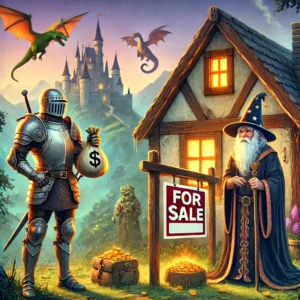Buyer’s vs. Seller’s Market
A Tale of Two Markets: The Buyer’s Market vs. the Seller’s Market
Once upon a time in a little place called Realtyville—yeah, I know, real original—the housing market was doing what it does best: confusing everyone. It was like a soap opera with the same plot every year, just with different actors. Interest rates go up, interest rates go down, houses sit there, people get desperate, and around we go again. It’s all a game, and if you don’t understand the rules, well, you’re gonna end up paying more than your neighbor—and nobody likes that.
The Tale of the Buyer’s Market
So, Realtyville found itself in this thing they call a buyer’s market. What does that mean? It means the houses are sitting there like sad puppies at the shelter, just hoping someone, anyone, will take them home. There are more houses than people who want ’em. You’ve got high inventory levels—that’s a fancy way of saying, “Too much stuff, not enough people to buy it.” Sellers are practically begging, offering to throw in the backyard grill, a couple of lawn chairs, and probably their dignity, just to close the deal.
You see, in a buyer’s market, the power shifts. Buyers can walk around with that swagger, knowing they’ve got the upper hand. Sellers, on the other hand, are trying to make their places look attractive, you know, the way someone suddenly starts exercising after they get dumped. Price reductions happen all over the place, and houses sit on the market like leftovers in the fridge. Not exactly inspiring stuff, but hey—that’s a buyer’s market for ya.

The Season of the Seller’s Market
But don’t worry, folks. The market always changes. Enter the seller’s market. Now the power flips! Suddenly, there aren’t enough houses to go around. Buyers are like panicked shoppers on Black Friday—throwing money at anything with four walls and a roof. Multiple offers, bidding wars, people offering their firstborn just to get a place. It’s ridiculous.
In a seller’s market, the house goes up, and before you can even say, “This place has potential,” there are a dozen offers on it, all above asking price. Sellers love it. Buyers hate it. It’s the circle of real estate life, except instead of lions, you’ve got mortgage brokers and closing costs.

The Importance of Knowing Which Market You’re In
Why does it matter whether you’re in a buyer’s or a seller’s market? Well, if you’re a buyer and it’s a buyer’s market, congratulations! You’ve got options. You can take your time, be choosy, negotiate the price down, and still have enough left over for a bottle of champagne to celebrate your “victory.”
But if it’s a seller’s market? Forget about it. You’ve got to be ready to move fast. Throw your hat in the ring and hope for the best. You might even have to pay over the asking price and convince the seller you’re a stable human being, which, let’s face it, can be a hard sell sometimes.
And for sellers, it’s pretty much the same deal in reverse. If it’s a seller’s market, you get to act like a king. Set your price high, and let the offers roll in. But in a buyer’s market, suddenly you’ve got to start negotiating—and maybe throw in that flat-screen TV you were hoping to take with you. It’s all about knowing the terrain, and playing the game accordingly.
Five Ways the People of Realtyville Determined the Market Conditions
Now, the folks in Realtyville had a few tricks up their sleeves to figure out whether it was a buyer’s or a seller’s market. And let me tell you, it wasn’t rocket science, but it worked.
- Supply and Demand: Look at how many houses are for sale versus how many people want ’em. High inventory means a buyer’s market—the houses are like teenagers on a dating app, just swiping right, hoping someone will choose them. Low inventory? Seller’s market. Now it’s the buyers swiping like crazy, desperate for a match.
- Price Trends: You watch those property prices. If prices are going up, ding-ding, it’s a seller’s market. If prices are staying flat or dropping? You’re back to the land of sad houses and desperate sellers.
- Days on Market (DOM): How long are these houses sitting there? If it’s forever, that’s a buyer’s market. If they’re disappearing before you even get your shoes on to go to an open house, seller’s market all the way.
- Rate of Price Reductions: Are sellers cutting their prices left and right? That means the buyers are in charge. No price cuts? It’s a feeding frenzy for the sellers, and they know it.
- Local Economy and Employment Trends: When everyone’s got a job and things are looking good, you better believe it’s a seller’s market. When people are out of work, well, suddenly that three-bedroom ranch isn’t quite as easy to sell.
The Interest Rate Factor
And let’s not forget interest rates—the silent puppet master pulling the strings behind the scenes. Interest rates go up, people’s willingness to buy goes down. Interest rates drop, and suddenly everyone thinks they’re Donald Trump buying up property like it’s Monopoly night at the family table.
- For Buyers: Low interest rates? Great, your mortgage payments are lower. You can buy more house and still have cash left for a new lawnmower. High rates? Now you’re calculating whether you really need that third bedroom or if you could get by with a tent in the backyard.
- For Sellers: Low-interest rates mean more buyers with more money. It’s like a buffet for sellers—just sit back and let them come. When rates rise, suddenly the offers aren’t coming in quite so fast. You might have to, you know, compromise. Ugh, compromise.
The Moral of the Story
The story of Realtyville is one of endless change—a bit like a soap opera that never ends, but without the fancy clothes and dramatic betrayals (well, most of the time). The market shifts, and it’s all about knowing where you stand. Buyer’s market? Seller’s market? Who cares, as long as you know how to play the game.
So remember, folks: Pay attention to the signs. Look at inventory, watch those prices, and keep an eye on interest rates. Because in Realtyville, timing is everything. And if you time it right, maybe—just maybe—you won’t end up as the sucker at the closing table.
And that, my friends, is the real estate market—as told by yours truly, with a healthy dose of sarcasm, because what else would you expect?

Signs of Recovery
Muskoka Cottage Prices: Trends, Insights, and What’s Next Muskoka has long been known for its tranquil lakes, breathtaking sunsets, and the quintessential Canadian cottage lifestyle.

Cottage Prices: The Wild Ride
https://youtu.be/8y7DQZ0NfUk?si=MAWwKtXVQdSK0ZrH The data shows a clear cycle of a hot market in 2022, followed by a correction in 2023, and a partial recovery in 2024.

A Tale of Two Markets: The Buyer’s Market vs. the Seller’s Market
Buyer’s vs. Seller’s Market A Tale of Two Markets: The Buyer’s Market vs. the Seller’s Market Once upon a time in a little place called

Before and After – the Moving Boxes
Moving Boxes and Memories: Tom and Eleanor’s Downsizing Journey Eleanor was in the kitchen, running her hand along the height marks on the doorframe that
